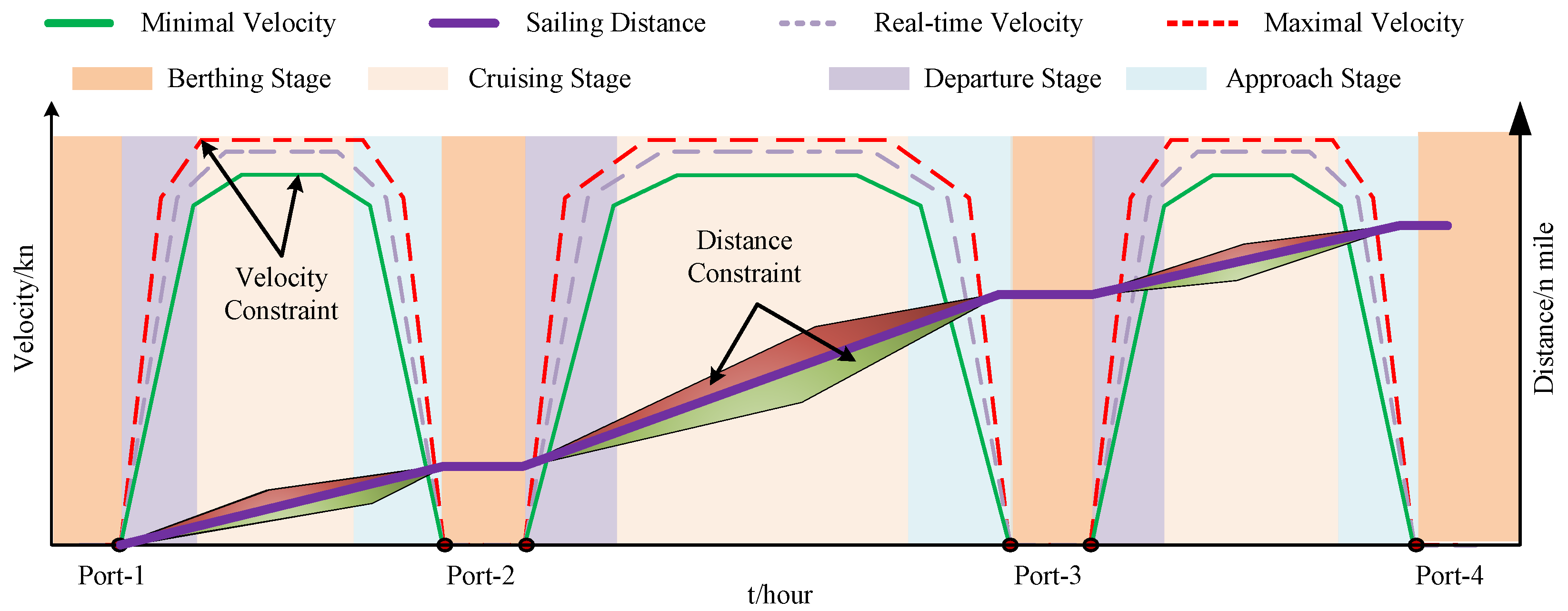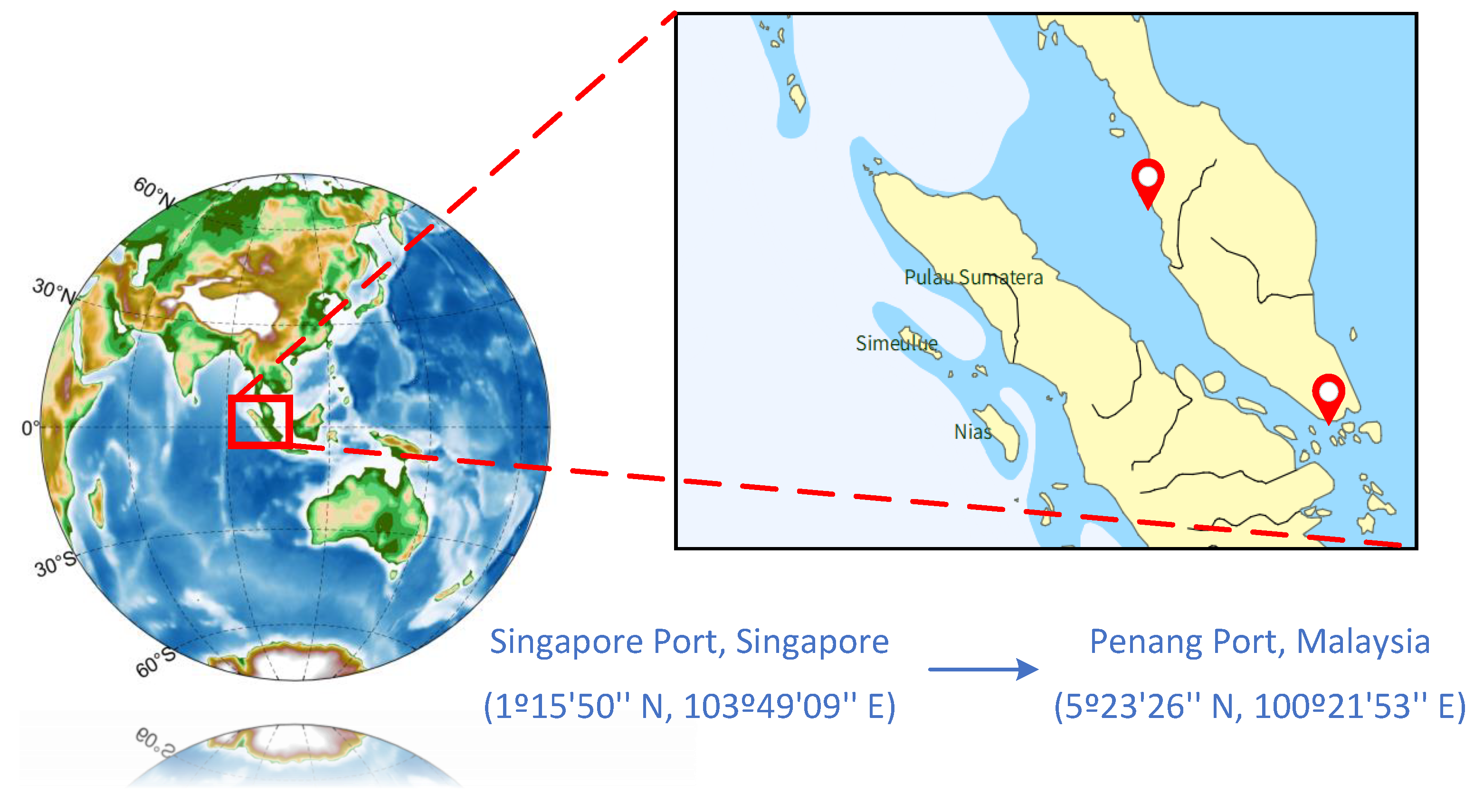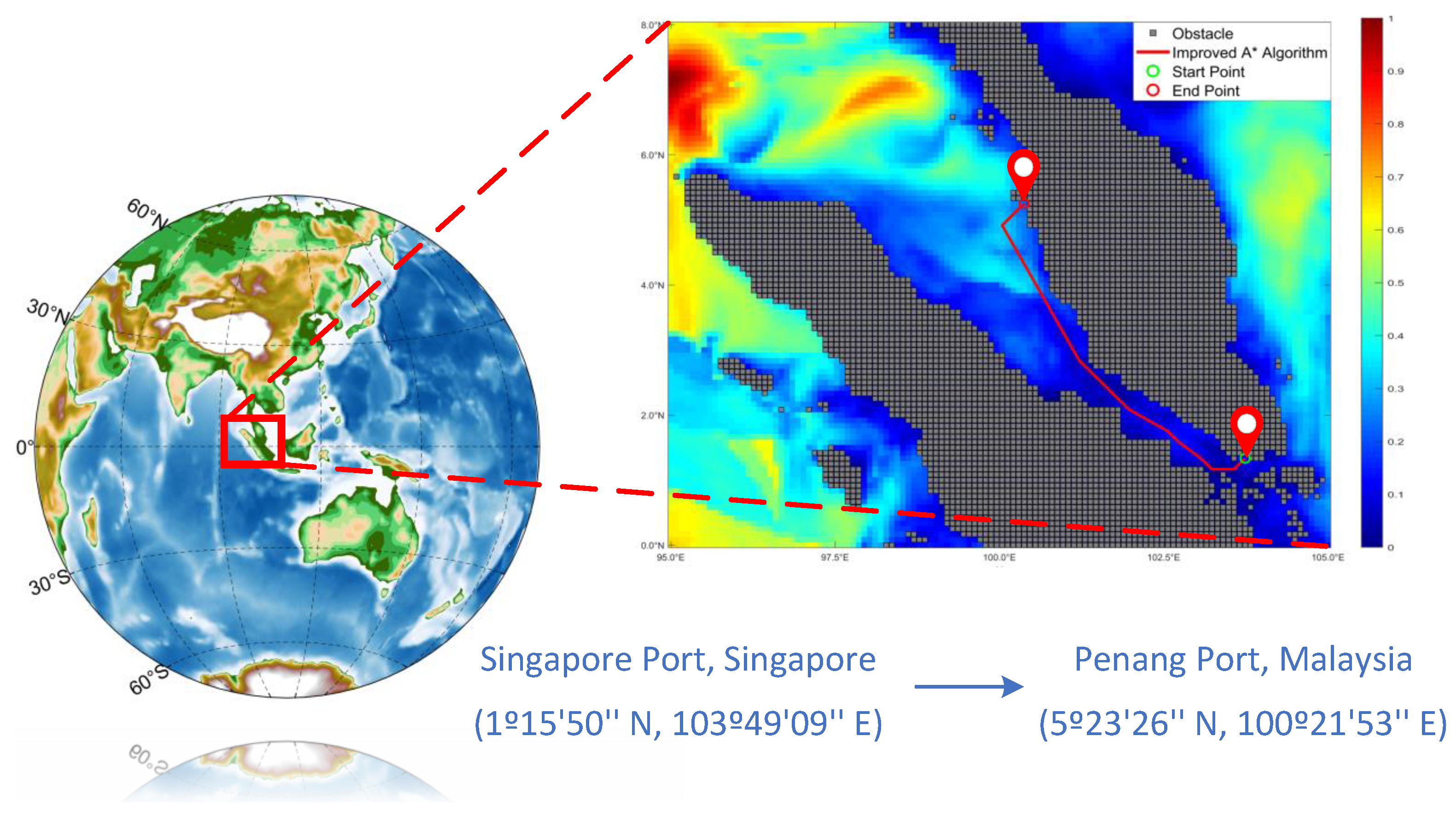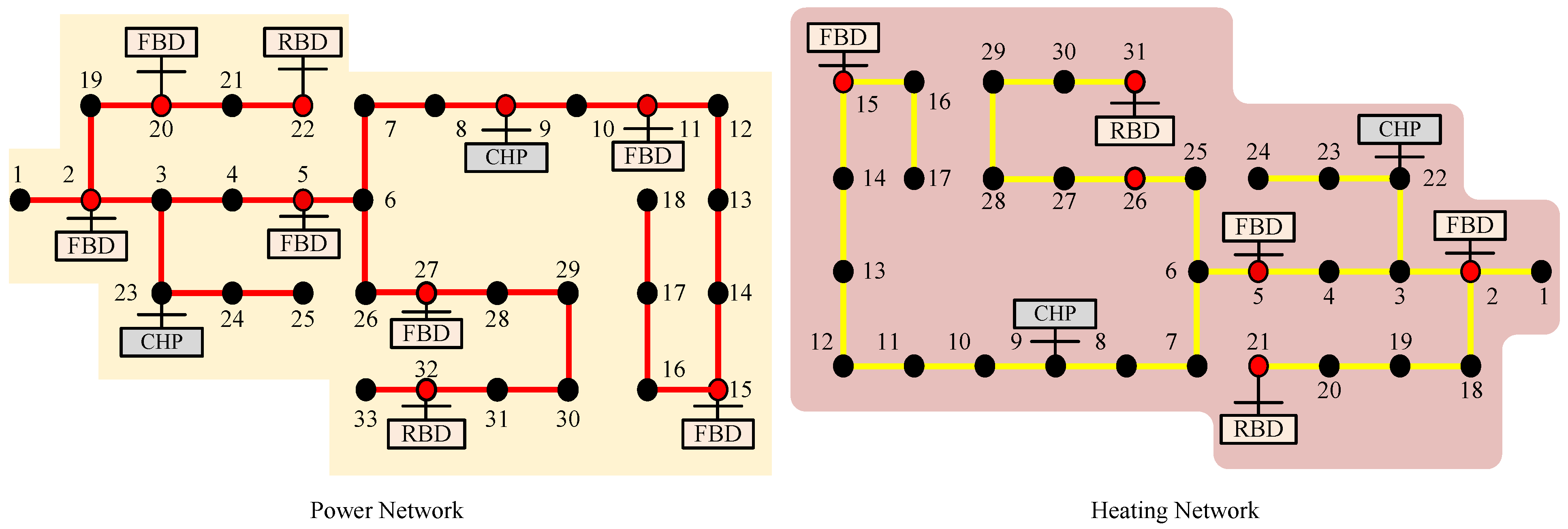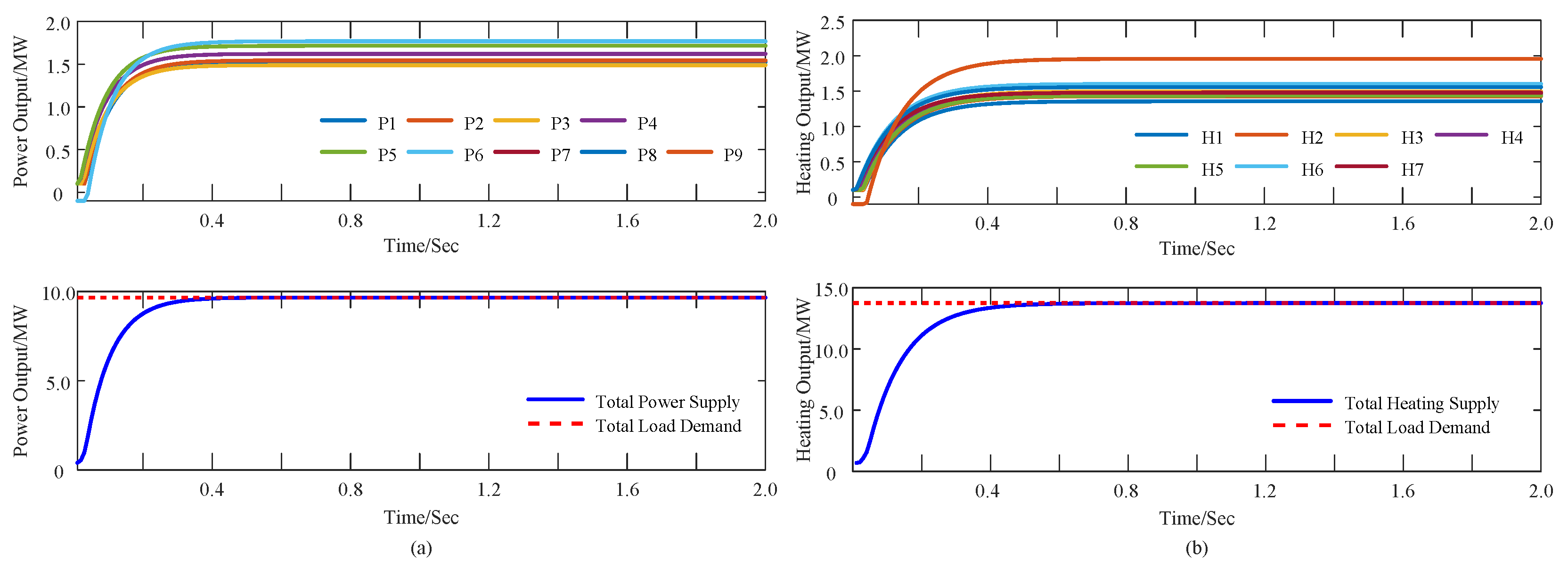1. Introduction
With the vigorous development of the shipping industry, its demand for fossil fuels has become increasingly strong, leading to a large amount of carbon emissions, which is contrary to the sustainable development of the marine ecological environment [
1]. To overcome these disadvantages, the ship-integrated energy system (S-IES), a promising energy structure that combines renewable energy resources with traditional fossil resources, can effectively improve energy utilization efficiency and has been widely studied in recent years [
2,
3].
The S-IES, with the energy conversion center as its hub, closely couples the marine power and heating networks, the shipboard communication network, and the ship’s propulsion system, enabling a sustained and high-quality energy supply. The energy management problem of the S-IES can be regarded as an optimization problem that provides appropriate energy output solutions for energy devices while satisfying all navigational requirements of the ship. It aims to ensure the safe and reliable operation of S-IES by seeking optimal energy output solutions. Meanwhile, energy management for S-IES, which ensures the high efficiency of diverse energy sources, has garnered significant research attention in recent years. Additionally, as a major factor in measuring the profitability of shipowner companies, the economic benefit is widely regarded as a critical optimization objective for energy management in S-IES [
4]. An all-electric ship concept with main and auxiliary generators is proposed in [
5], where the energy management problem aims to balance energy storage and power generation. To minimize battery-swapping operational costs, the authors in [
6] developed an energy management model for all-electric ships with constraints on velocity and battery utilization. To enhance secure operation, the authors in [
7] integrated supply–demand requirements into the energy management analysis. Meanwhile, with the advancements in intelligent technologies and shipboard building technologies, the ship’s energy systems exhibit distinct regional and autonomous features [
8]. To this end, the “energy body” concept is developed to embody the structural characteristics, enabling bidirectional energy exchange between independent energy blocks. However, existing research has focused on economic benefits and ship structural characteristics while neglecting the hazards posed by significant carbon emissions. Furthermore, to mitigate the massive carbon emissions of the shipping industry, the International Maritime Organization (IMO), a specialized agency responsible for ensuring the safety and security of the shipping industry, has drafted numerous rules and regulations to reduce carbon emissions. Among these, the most notable is the carbon intensity indicator rating policy. According to the ship’s CII value, ships can be classified into five grades, ranging from A to E, based on their type. In this regard, Grade A presents the highest performance, indicating the lowest carbon emission intensity and the most environmentally friendly option. The IMO encourages official institutions to introduce market trading mechanisms into the CII rating system [
9], that is, to impose fines on ships with lower ratings. Therefore, in the analysis of ship energy management issues, it is crucial to optimize both the economic and environmental benefits for ships synergistically.
On the other hand, the approaches to tackle the energy management problem of the S-IES can be categorized into two primary types: centralized and distributed strategies [
10]. Specifically, the centralized algorithms for addressing the energy management problem of the S-IES exhibit high accuracy in deriving optimal solutions. However, such manners are susceptible to single-point failures due to their reliance on a central controller [
11]. Additionally, centralized algorithms require high-bandwidth communication infrastructure, which the shipboard energy systems may not support. Meanwhile, with the advancement of renewable energy and information technologies, an increasing number of non-professional energy participants have been installed on ships, driving the S-IES toward a flatter, more distributed architecture. Due to the plug-and-play nature of S-IES, both the physical transmission and communication networks of S-IES are prone to variability, which can significantly undermine the effectiveness of centralized strategies. On the contrary, distributed methods characterized by faster computation and lower communication requirements have emerged as a promising option for addressing the energy management problem of the S-IES in recent years. To address the economic scheduling problem, the authors in [
12] propose a fully distributed consensus algorithm for the smart grid. To ensure operational security, a distributed energy management strategy is developed in [
13] based on the alternating direction method of multipliers to solve the energy management problem with the voltage security constraints.
As we know, the secure operation of S-IES’s energy management not only depends on the coordination between energy participants but is also closely linked to complex marine conditions [
14]. The complex marine conditions and variable weather have posed significant challenges to the construction of marine risk field models [
15]. Meanwhile, traditional route planning methods rely excessively on the mariners’ subjective experience, with a fundamental flaw in the lack of effective assessment of marine environmental risks. The existing methods fail to fully consider the impact of hydrological and meteorological factors on ship navigation security [
16]. To overcome this disadvantage, risk assessment, as a systematic method capable of identifying, analyzing, and responding to massive hazards, has been widely applied in natural risk assessment and management research. Moreover, with the advancement of research, risk assessment methods have been gradually extended to various fields. Additionally, to quantify risk values, assessment methods are usually combined with technologies such as remote sensing [
17], numerical simulation [
18], and multi-criteria decision analysis [
19] to construct comprehensive evaluation systems. The authors in [
20], aiming to assess the Arctic navigation environment and accident risk, use environmental impact factors to construct a typical accident risk assessment model for the Arctic sea area. The authors in [
21] identify fog and ice accretion as the main risks of extreme weather, objectively demonstrate the distribution changes of navigation risks, and provide a reliable basis for route planning. The authors in [
22] propose a ship navigation risk assessment method in marine wind farm waters based on a multi-factor fuzzy analytic hierarchy process, which significantly reduces navigation risks. As noted, a single-factor risk can only reflect the independent impact of a single variable on navigation security. However, in the actual marine environment, risk factors can interact with one another. For example, strong winds may lead to larger waves, which in turn affect the stability and maneuverability of ships. The direction and speed of ocean currents may cause ships to deviate from their planned routes, increasing the risk of colliding with islands or reefs. Therefore, it is crucial to consider the synergy of multiple risk factors and develop a marine environmental risk field model to ensure secure sailing.
Additionally, numerous distributed algorithms, such as Newton’s descent algorithms [
7] and gradient descent algorithms [
23], have been widely employed to address the energy management problem for the S-IES. Unlike traditional energy systems, the load demand of a ship’s propulsion system requires a rapid and accurate response, depending on the navigation environment. Therefore, it is essential to prioritize their computational efficiency when designing energy management algorithms.
With these motivations, the energy management problem of the S-IES is analyzed under the marine environmental risk field. The major contributions are as follows: (1) To address the negative impacts of multiple risk hazards on ship navigational safety in complex marine environments, a marine environmental risk field model is constructed that integrates geographical environment and hydrological data. (2) To decrease the carbon emissions generated by S-IES, an energy management model aiming at maximal economic and environmental benefits is developed. Furthermore, a distributed algorithm is designed with the concept of finite-time consensus, ensuring a rapid and accurate response to load demands.
The remainder of this paper is organized as follows.
Section 2 constructs a marine environmental risk field model. An energy management model and a distributed algorithm based on the finite-time consensus theory are proposed in
Section 3. Meanwhile, the mathematical analysis is illustrated in
Section 3.
Section 4 concludes the paper, demonstrating its effectiveness through simulation experiments. For clarity, key symbol annotations are provided in
Table 1.
2. Sailing Route Design Under Marine Environmental Risk Field Model
This section presents the ship route design procedure, which involves constructing a marine environmental risk field model and optimizing velocity planning.
2.1. Marine Environmental Risk Field Model
Ship navigation is highly susceptible to complex marine conditions. To enhance the reliability of ship energy management systems, a marine environmental risk field model is constructed, and the operational framework is depicted in
Figure 1.
Step 1: Data Collection and Preprocessing
Geographic features and oceanographic parameters of the target maritime area are collected and preprocessed. Ship navigation operations are highly susceptible to disturbances from complex marine conditions, particularly wind, waves, currents, and submerged rocks. Currently, meteorological data (e.g., wind, waves, and currents) are predominantly stored in NetCDF (Network Common Data Form) format, while features such as submerged rocks use Shapefile formats. To meet geospatial analysis requirements, heterogeneous marine condition data must be unified into a single vector data format. Precisely for this purpose, ArcGIS 10.7 software is utilized to convert NetCDF datasets into Shapefile format. This standardization enables subsequent spatial analysis and cartographic operations.
Furthermore, marine remote sensing data predominantly consists of time-series dynamic datasets that require periodic updates. To extract valid information, temporal averaging is applied to data collected over a specific time interval, with the results ultimately rendered in raster format. However, disparities in data sources may lead to adverse outcomes, such as inconsistent spatial resolutions in raster data. To mitigate errors induced by resampling heterogeneous data to a unified resolution, the Kriging interpolation method is employed.
Step 2: Hazard Factor Analysis and Evaluation Criteria Construction
The main hazard factors can be attributed to sea breezes, ocean waves and currents, and terrain environments.
Sea breeze: The wind–wave coupling effect readily induces violent ship motions, including roll, pitch, and heave. Specifically, roll motion may cause excessive hull heeling beyond safety limits and stability loss; pitch motion amplifies vertical slamming loads on bow and stern structures; heave motion triggers propeller ventilation (cavitation) or deck immersion by waves.
Ocean wave: Drastic variations in parameters such as wave height and period compromise hull stability. Heavy wave conditions not only force a ship’s velocity reduction but also significantly increase the collision probabilities with floating debris, leading to exponentially escalating risks of equipment damage.
Ocean current: To ensure ships maintain their intended sailing route with changing ocean currents, continuous heading adjustments are required to preserve the target course. Simultaneously, currents significantly impact the ship’s velocity relative to the ground.
Terrain environment: Navigational risks in shallow waters exhibit nonlinear characteristics. The wave-making resistance increases as the ratio of actual water depth to the ship’s draft falls below the safety threshold. Concurrently, the ship sinkage increases exponentially with velocity, directly triggering a nonlinear surge in grounding probability.
Specifically, sea breeze risk degree quantifies wind impact intensity on ships, measured by wind speed, with higher velocities proportionally increasing risk levels. Wave risk degree reflects the intensity of wave impact, gauged by wave height, where higher heights correspond to greater risk. The degree of ocean current risk indicates operational challenges induced by currents as higher flow velocities degrade maneuverability and amplify risk. The risk degrees
for these factors are mathematically formulated as (
1).
where
represents the actual value of the corresponding hazard factor within each grid cell.
denotes the minimal value of the corresponding hazard factor.
i denotes the index of a hazard factor within the set
, where
.
,
, and
denote the sets of sea breeze parameters, wave parameters, and ocean current parameters respectively, each containing all values from their corresponding datasets. (
1) is designed to achieve dimensionless normalization of the risk factors. Meanwhile, it ensures the nonlinear amplification effect in high-risk areas (for example, when wind speed or wave height exceeds the threshold, the risk increases exponentially). This form is common in engineering risk assessments (such as wind disaster and tsunami models).
Additionally, the water depth risk level is derived from navigable depth, where shallower depths increase navigational hazards, as defined in (
2).
where
denotes draft,
represents under keel clearance, and
signifies wave height.
presents the set of terrain environment parameters.
Step 3: Risk Field Model Design
Single-factor risk spatial visualization requires integrating risk assessment models with Geographic Information System (GIS) technology. It is based on single-element risk quantification models and combines spatial interpolation algorithms and raster operation modules within GIS platforms. These components collectively accomplish the construction of multidimensional marine risk assessment thematic maps. Specifically, utilizing heat map visualization, risk maps for four hazard factors (sea breeze, ocean wave, ocean current, and terrain environment) can be generated based on their respective data and methods as listed in
Table 2. Then, the heat map visualization of each hazard factor is presented in
Figure 2.
As depicted in
Figure 2, red high-value zones indicate hazardous areas unsuitable for operations, while blue low-value zones represent safe navigation corridors. The risk index is normalized to a continuous scale of 0 to 1, where zero corresponds to optimal navigation conditions, and 1 signifies a hazardous navigational state. This achieves visualized hierarchical warnings for risks in complex marine environments.
However, marine environmental risk factors exhibit significant spatiotemporal coupling characteristics. Consequently, single-factor analysis can only provide partial insight into risk perception, necessitating the development of a multi-factor, synergistic assessment model to reveal the interaction mechanisms among elements. To address this, this study adopts a multi-factor superposition analysis method, achieving synergistic risk assessment through a normalized quantification model.
However, marine environmental risk factors exhibit significant spatiotemporal coupling characteristics. To overcome the disadvantage of single-factor analysis, a multi-factor synergistic assessment model is constructed. The assessment model relies on the weighted summation of risk factor indicators, which can be expressed as (
3).
where
and
k are the grid set and its index.
presents the weighted parameter vector at the
kth grad. The weighted parameters are acquired by the combination of the Analytic Hierarchy Process method and the entropy weight method. The selecting mechanism improves the objectivity and accuracy of evaluation results.
presents the risk degree vector describing hazard factors at the
kth grad. Therein,
,
,
, and
.
is the cardinality of the corresponding set.
Subsequently, marine environmental risk values calculated via (
3) are classified into four risk levels, as definitively tabulated in
Table 3.
This developed marine environmental risk field model enables a multidimensional assessment of risks as the ship sails through, utilizing quantitative computation and visual representation of spatial data to provide geospatial decision support for route planning.
2.2. Velocity Plan
Optimized sailing routes can be efficiently generated using A
∗ algorithms, genetic algorithms, or ant colony optimization algorithms. Security can be enhanced by leveraging the spatial assessment results of the marine environmental risk field model. However, a complete navigational mission plan comprises not only route information but also requires velocity planning. Subsequently, accounting for the ship’s navigation characteristics, the primary objective in designing the velocity profile is to
where
T denotes the total sailing duration. The sailing stage set is defined as
, where
,
,
, and
represent the ship’s berthing, departure, cruising, and approach stages, respectively.
Furthermore, ensuring safe navigation requires adherence to a set of operational constraints. The ship’s voyage profile is depicted in
Figure 3. As shown in
Figure 3, it indicates that the ships have different velocity limitations during different sailing stages while executing navigational missions. In other words, it reminds us that when optimizing a sailing route, not only the complex marine environment should be taken into account, but also the ship’s operating characteristics need to be considered. Moreover, timely or early arrival at the port according to the scheduled timeframe should be guaranteed.
Then, the requirements for the ship’s sailing can be presented as
where (
5) and (
6) represent the velocity and sailing distance constraints, respectively. Specifically,
and
denote the minimum and maximum velocities for each sailing stage, respectively.
denotes the state variable, defined as
, where
and
represent the state variables of each sailing stage. Meanwhile,
during the berthing stage (
), and similar operational principles apply to other sailing stages.
is a constant time slot.
denotes the distance between Port
p and Port
q, where
.
Remark 1. The load demand of the ship’s propulsion system will rise sharply in case of dangerous situations to maintain the ship’s normal sailing velocity. Thus, the developed marine environmental risk field model facilitates the implementation of energy management analyses for ships.
Then, the state variable
should obey
Therefore, the velocity optimization problem can be formulated as
Through the above analysis, an optimal velocity profile can be generated for the sailing route under the marine environmental risk field model. Meanwhile, a load demand curve can be derived using the mathematical relationship between the ship’s velocity and its propulsion system load requirement. This optimized velocity scheme ensures that ships complete the navigation mission both safely and efficiently.


